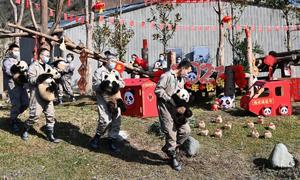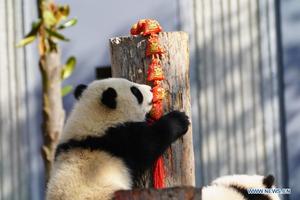 Ten panda cubs born last year meet the public at the China Conservation and Research Center for the Giant Panda's Shenshuping base in Wenchuan, Sichuan province, on Wednesday. (PHOTO / CHINA NEWS SERVICE)
Ten panda cubs born last year meet the public at the China Conservation and Research Center for the Giant Panda's Shenshuping base in Wenchuan, Sichuan province, on Wednesday. (PHOTO / CHINA NEWS SERVICE)
Ten panda cubs born in 2020 made their debut in Wenchuan county, Sichuan province, on Wednesday, which was Lichun, or the beginning of spring, the first solar term in the Chinese lunar calendar.
At 11 am, keepers took the 10 panda cubs to a playground of the Shenshuping base of the China Conservation and Research Center for the Giant Panda, where they were given treats and played on a toy train and castle.
"They kept smelling and biting the new toys, and it was apparent that they liked the train and castle," said Zhang Guiquan, a panda expert at the base, which was set up in 1980 under an agreement between the World Wide Fund for Nature, formerly the World Wildlife Fund, and the Chinese government.
 Breeders pose for a group photo with giant panda cubs born in 2020 at Shenshuping base of China Conservation and Research Center for Giant Pandas in Wolong National Nature Reserve, Southwest China's Sichuan province, Feb 3, 2021. (PHOTO / XINHUA)
Breeders pose for a group photo with giant panda cubs born in 2020 at Shenshuping base of China Conservation and Research Center for Giant Pandas in Wolong National Nature Reserve, Southwest China's Sichuan province, Feb 3, 2021. (PHOTO / XINHUA)
The average age of the 10 cubs is around 6 months, with the oldest twin sisters being more than 190 days and the youngest being more than 120 days.
"All of the 10 cubs were conceived naturally," Zhang said.
It would have been close to impossible to increase the captive panda population if the center had not resolved the difficulties in panda breeding it encountered in its early days.
In 1992, the center housed just 10 pandas, but now it is home to 330, the world's largest captive panda population out of a total of 633, said Zhang Hemin, the center's executive deputy director.
 A giant panda cub born in 2020 plays at Shenshuping base of China Conservation and Research Center for Giant Pandas in Wolong National Nature Reserve, Southwest China's Sichuan province, Feb 3, 2021. (PHOTO / XINHUA)
A giant panda cub born in 2020 plays at Shenshuping base of China Conservation and Research Center for Giant Pandas in Wolong National Nature Reserve, Southwest China's Sichuan province, Feb 3, 2021. (PHOTO / XINHUA)
 A giant panda cub born in 2020 plays at Shenshuping base of China Conservation and Research Center for Giant Pandas in Wolong National Nature Reserve, Southwest China's Sichuan province, Feb 3, 2021. (PHOTO / XINHUA)
A giant panda cub born in 2020 plays at Shenshuping base of China Conservation and Research Center for Giant Pandas in Wolong National Nature Reserve, Southwest China's Sichuan province, Feb 3, 2021. (PHOTO / XINHUA)
Explaining how difficult the task was, he said researchers at first did not know about the pandas' habits.
Thinking that they preferred a solitary life, researchers kept each panda isolated in a tiny den. But the pandas became depressed and had difficulty breeding, he said.
In the course of studies initiated in 1992, researchers provided captive pandas with more opportunities to communicate socially with each other and play.
Male and female pandas were swapped into the dens of the opposite sex so that each would know the smell of the other.
 A giant panda cub born in 2020 plays at Shenshuping base of China Conservation and Research Center for Giant Pandas in Wolong National Nature Reserve, Southwest China's Sichuan province, Feb 3, 2021. (PHOTO / XINHUA)
A giant panda cub born in 2020 plays at Shenshuping base of China Conservation and Research Center for Giant Pandas in Wolong National Nature Reserve, Southwest China's Sichuan province, Feb 3, 2021. (PHOTO / XINHUA)
 A giant panda cub born in 2020 plays at Shenshuping base of China Conservation and Research Center for Giant Pandas in Wolong National Nature Reserve, Southwest China's Sichuan province, Feb 3, 2021. (PHOTO / XINHUA)
A giant panda cub born in 2020 plays at Shenshuping base of China Conservation and Research Center for Giant Pandas in Wolong National Nature Reserve, Southwest China's Sichuan province, Feb 3, 2021. (PHOTO / XINHUA)
In addition, to get them to move around and be more active, researchers placed biscuits rich in trace elements and vitamins in places the pandas could not find easily.
The abandonment of newborn panda cubs was another common problem, as 50 percent of the newborns are typically twins, and the mother would end up caring for only one and abandoning the other cub.
The researchers solved the problem by removing the deserted cub and feeding it milk. They would then switch it with the favored cub from time to time, so the mother unwittingly supported both cubs.
huangzhiling@chinadaily.com.cn


